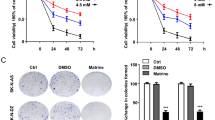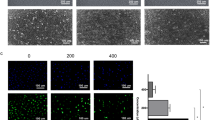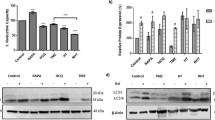Abstract
Neuroblastoma (NB) is the common pediatric tumor of the sympathetic nervous system characterized by poor prognosis. Owing to the challenges such as high tumor heterogeneity, multidrug resistance, minimal residual disease, etc., there is an immediate need for exploring new therapeutic strategies and effective treatments for NB. Herein, in the current study, we explored the unexplored response of NB cells to the second-generation histone deacetylase inhibitor (HDACi) JNJ-26481585(JNJ) and the lysosomotropic agent, Chloroquine (CQ) alone and upon JNJ/CQ treatment as a plausible therapeutic. We identify that while JNJ alone induced autophagy in NB cells, JNJ/CQ treatment decreased the viability and proliferation of NB cells in vitro by switching from autophagy to apoptosis. Further we found that autophagy inhibition by CQ pre-treatment led to the generation of ROS and a decrease in the mitochondrial membrane potential (MMP) that subsequently caused caspase-3-mediated apoptotic cell death in NB cells. Corroborating the above observations, we found that the ROS scavenger N-acetylcysteine (NAC) countered caspase-3 activity and the cells were rescued from apoptosis. Finally, these observations establish that JNJ/CQ treatment resulted in cell death in NB cells by triggering the formation of ROS and disruption of MMP, suggesting that modulation of JNJ-induced autophagy by CQ represents a promising new therapeutic approach in NB.






Similar content being viewed by others
References
Matthay KK, Maris JM, Schleiermacher G et al (2016) Neuroblastoma. Nat Rev Dis Prim 2:16078. https://doi.org/10.1038/nrdp.2016.78
Maris JM (2010) Recent advances in neuroblastoma. N Engl J Med 362:2202–2211. https://doi.org/10.1056/NEJMra0804577
Esposito MR, Aveic S, Seydel A et al (2017) Neuroblastoma treatment in the post-genomic era. J Biomed Sci 24:14. https://doi.org/10.1186/s12929-017-0319-y
Pinto NR, Applebaum MA, Volchenboum SL, Matthay KK, London WB, Ambros PF et al (2015) Advances in risk classification and treatment strategies for neuroblastoma. J Clin Oncol 33(27):3008–3017. https://doi.org/10.1200/JCO.2014.59.4648
Ladenstein R, Pötschger U, Pearson AD, Brock P, Luksch R, Castel V et al (2017) Busulfan and melphalan versus carboplatin, etoposide, and melphalan as high-dose chemotherapy for high-risk neuroblastoma (HR-NBL1/SIOPEN): an international, randomised, multi-arm, open-label, phase 3 trial. Lancet Oncol 18(4):500–514. https://doi.org/10.1016/S1470-2045(17)30070-0
Brodeur GM, Bagatell R (2014) Mechanisms of neuroblastoma regression. Nat Rev Clin Oncol 12:704–713. https://doi.org/10.1038/nrclinonc.2014.168
West AC, Johnstone RW (2014) New and emerging HDAC inhibitors for cancer treatment. J Clin Invest 124(1):30–39. https://doi.org/10.1172/JCI69738
Lee J-H, Choy M, Ngo L, Foster S, Marks PA (2010) Histone deacetylase inhibitor induces DNA damage, which normal but not transformed cells can repair. Proc Natl Acad Sci USA 107:14639–14644. https://doi.org/10.1073/pnas.1008522107
Venugopal B, Baird R, Kristeleit RS, Plummer R, Cowan R, Stewart A et al (2013) A phase I study of quisinostat (JNJ-26481585), an oral hydroxamate histone deacetylase inhibitor with evidence of target modulation and antitumor activity, in patients with advanced solid tumors. Clin Cancer Res 19(15):4262–4272. https://doi.org/10.1158/1078-0432.CCR-13-0312
Mizushima N, Komatsu M (2011) Autophagy: renovation of cells and tissues. Cell 147(4):728–741. https://doi.org/10.1016/j.cell.2011.10.026
Bialik S, Dasari SK, Kimchi A (2018) Autophagy-dependent cell death - where, how and why a cell eats itself to death. J Cell Sci 131(18):jcs215152. https://doi.org/10.1242/jcs.215152
Udristioiu A, Nica-Badea D (2019) Autophagy dysfunctions associated with cancer cells and their therapeutic implications. Biomed Pharmacother 115:108892. https://doi.org/10.1016/j.biopha.2019.108892
Jiang J, Li H, Qaed E, Zhang J, Song Y, Wu R et al (2018) Salinomycin, as an autophagy modulator- a new avenue to anticancer: a review. J Exp Clin Cancer Res 37(1):26. https://doi.org/10.1186/s13046-018-0680-z
Kaminskyy VO, Piskunova T, Zborovskaya IB, Tchevkina EM, Zhivotovsky B (2012) Suppression of basal autophagy reduces lung cancer cell proliferation and enhances caspase-dependent and -independent apoptosis by stimulating ROS formation. Autophagy 8:1032–1044. https://doi.org/10.4161/auto.20123
Rubinsztein DC, Gestwicki JE, Murphy LO, Klionsky DJ (2007) Potential therapeutic applications of autophagy. Nat Rev Drug Discov 6:304–312
Singh SS, Vats S, Chia AY, Tan TZ, Deng S, Ong MS et al (2017) Dual role of autophagy in hallmarks of cancer. Oncogene 37(9):1142–1158. https://doi.org/10.1038/s41388-017-0046-6
Turcotte S, Giaccia AJ (2010) Targeting cancer cells through autophagy for anticancer therapy. Curr Opin Cell Biol 22(2):246–251. https://doi.org/10.1016/j.ceb.2009.12.007
Wang F, Tang J, Li P, Si S, Yu H, Yang X, Tao J, Lv Q, Gu M, Yang H, Wang Z (2018) Chloroquine enhances the radiosensitivity of bladder cancer cells by inhibiting autophagy and activating apoptosis. Cell Physiol Biochem 45:54–66. https://doi.org/10.1159/000486222
Avniel-Polak S, Leibowitz G, Riahi Y, Glaser B, Gross DJ, Grozinsky-Glasberg S (2016) Abrogation of autophagy by chloroquine alone or in combination with mTOR inhibitors induces apoptosis in neuroendocrine tumor cells. Neuroendocrinology 103:724–737. https://doi.org/10.1159/000442589
Ye H, Chen M, Cao F, Huang H, Zhan R, Zheng X (2016) Chloroquine, an autophagy inhibitor, potentiates the radiosensitivity of glioma initiating cells by inhibiting autophagy and activating apoptosis. Bmc Neurol 16(1):178. https://doi.org/10.1186/s12883-016-0700-6
Makowska A, Eble M, Prescher K, Hoss M, Kontny U (2016) Chloroquine sensitizes nasopharyngeal carcinoma cells but not nasoepithelial cells to irradiation by blocking autophagy. PLoS ONE 11:e166766. https://doi.org/10.1371/journal.pone.0166766
Fischer C, Petriccione M, Donzelli M et al (2016) Improving care in pediatric neuro-oncology patients: an overview of the unique needs of children with brain tumors. J Child Neurol 31(4):488–505. https://doi.org/10.1177/0883073815597756
Gammoh N, Lam D, Puente C et al (2012) Role of autophagy in histone deacetylase inhibitor-induced apoptotic and nonapoptotic cell death. Proc Natl Acad Sci USA 109(17):6561–6565. https://doi.org/10.1073/pnas.1204429109
Yu L, Chen Y, Tooze SA (2017) Autophagy pathway: cellular and molecular mechanisms. Autophagy 14(2):207–215. https://doi.org/10.1080/15548627.2017.1378838
Karna P, Zughaier S, Pannu V, Simmons R, Narayan S, Aneja R (2010) Induction of reactive oxygen species-mediated autophagy by a novel microtubule-modulating agent. J Biol Chem 285:18737–18748. https://doi.org/10.1074/jbc.M109.091694
D'Anneo A, Carlisi D, Lauricella M, Puleio R, Martinez R, Di Bella S et al (2013) Parthenolide generates reactive oxygen species and autophagy in MDA-MB231 cells. A soluble parthenolide analogue inhibits tumour growth and metastasis in a xenograft model of breast cancer. Cell Death Dis 4:e891. https://doi.org/10.1038/cddis.2013.415
Bento CF, Renna M, Ghislat G, Puri C, Ashkenazi A, Vicinanza M, Menzies FM, Rubinsztein DC (2016) Mammalian autophagy: how does it work? Annu Rev Biochem 85:685–713. https://doi.org/10.1146/annurev-biochem-060815-014556
Galluzzi L, Bravo-San Pedro JM, Levine B, Green DR, Kroemer G (2017) Pharmacological modulation of autophagy: therapeutic potential and persisting obstacles. Nat Rev Drug Discov 16(7):487–511. https://doi.org/10.1038/nrd.2017.22
Klionsky DJ, Abdelmohsen K, Abe A et al (2016) Guidelines for the use and interpretation of assays for monitoring autophagy. Autophagy 12(1):1–222. https://doi.org/10.1080/15548627.2015.1100356
Du Toit A, Hofmeyr JS, Gniadek TJ, Loos B (2018) Measuring autophagosome flux. Autophagy 14(6):1060–1071. https://doi.org/10.1080/15548627.2018.1469590
Mauvezin C, Neufeld TP (2015) Bafilomycin A1 disrupts autophagic flux by inhibiting both V-ATPase-dependent acidification and Ca-P60A/SERCA-dependent autophagosome-lysosome fusion. Autophagy 11(8):1437–1438. https://doi.org/10.1080/15548627.2015.1066957
Nita M, Grzybowski A (2016) The role of the reactive oxygen species and oxidative stress in the pathomechanism of the age-related ocular diseases and other pathologies of the anterior and posterior eye segments in adults. Oxid Med Cell Longev 2016:3164734. https://doi.org/10.1155/2016/3164734
Marchi S, Giorgi C, Suski JM, Agnoletto C, Bononi A, Bonora M et al (2012) Mitochondria-ROS crosstalk in the control of cell death and aging. J Signal Transduct 2012:329635. https://doi.org/10.1155/2012/329635
Zhang X, ZengX LiangX et al (2014) The chemotherapeutic potential of PEG-b-PLGA copolymer micelles that combine chloroquine as autophagy inhibitor and docetaxel as an anti-cancer drug. Biomaterials 35(33):9144–9154. https://doi.org/10.1016/j.biomaterials.2014.07.028
Aldini G, Altomare A, Baron G (2018) N-Acetylcysteine as an antioxidant and disulphide breaking agent: the reasons why. Free Radic Res 52(7):751–762. https://doi.org/10.1080/10715762.2018.1468564
Mauthe M, Orhon I, Rocchi C, Zhou X, Luhr M, Hijlkema K et al (2018) Chloroquine inhibits autophagic flux by decreasing autophagosome-lysosome fusion. Autophagy 1:21. https://doi.org/10.1080/15548627.2018.1474314
HanW SJ, Feng L et al (2011) Autophagy inhibition enhances daunorubicin-induced apoptosis in K562 cells. PLoS ONE 6(12):e28491. https://doi.org/10.1371/journal.pone.0028491
Acknowledgements
VKK thanks University Grants Commission (UGC) (Award No.22/06/2014 (i) EU-r) & DK thanks Council of Scientific & Industrial Research (CSIR) for SRF (Award No. 31/14(2691/2017-EMR-I). CSIR- IICT Manuscript communication No. is IICT/Pubs./2019/072.
Author information
Authors and Affiliations
Contributions
VKK planned, designed the experiments, collected, and analyzed the data. DK validated the results and repeated the experiments. ADT conceived and supervised the research work, interpreted the data, and drafted the manuscript. All authors read and approved the final manuscript.
Corresponding author
Ethics declarations
Conflict of interest
The authors declare that they have no conflict of interest.
Ethical approval
This article does not contain any studies with animals performed by any of the authors.
Additional information
Publisher's Note
Springer Nature remains neutral with regard to jurisdictional claims in published maps and institutional affiliations.
Electronic supplementary material
Below is the link to the electronic supplementary material.
Rights and permissions
About this article
Cite this article
Kommalapati, V.K., Kumar, D. & Tangutur, A.D. Inhibition of JNJ-26481585-mediated autophagy induces apoptosis via ROS activation and mitochondrial membrane potential disruption in neuroblastoma cells. Mol Cell Biochem 468, 21–34 (2020). https://doi.org/10.1007/s11010-020-03708-8
Received:
Accepted:
Published:
Issue Date:
DOI: https://doi.org/10.1007/s11010-020-03708-8




